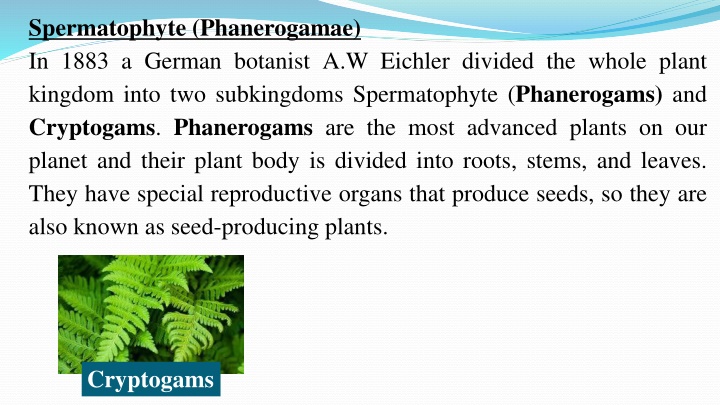
Spermatophytes: Phanerogams vs. Cryptogams & Angiosperms vs. Gymnosperms
"Explore the fascinating world of spermatophytes, where German botanist A.W. Eichler's classification introduced Spermatophytes and Cryptogams. Learn the differences between the advanced Phanerogams and the spore-producing Cryptogams, and discover the distinct features of Angiosperms and Gymnosperms. Delve into the classification based on cotyledons in Angiosperms, distinguishing Dicotyledoneae plants from Monocotyledoneae plants. Dive into the intricate details of plant reproductive organs and vascular systems in this enlightening botanical journey."
Download Presentation

Please find below an Image/Link to download the presentation.
The content on the website is provided AS IS for your information and personal use only. It may not be sold, licensed, or shared on other websites without obtaining consent from the author. If you encounter any issues during the download, it is possible that the publisher has removed the file from their server.
You are allowed to download the files provided on this website for personal or commercial use, subject to the condition that they are used lawfully. All files are the property of their respective owners.
The content on the website is provided AS IS for your information and personal use only. It may not be sold, licensed, or shared on other websites without obtaining consent from the author.
E N D
Presentation Transcript
Spermatophyte (Phanerogamae) In 1883 a German botanist A.W Eichler divided the whole plant kingdom into two subkingdoms Spermatophyte (Phanerogams) and Cryptogams. Phanerogams are the most advanced plants on our planet and their plant body is divided into roots, stems, and leaves. They have special reproductive organs that produce seeds, so they are also known as seed-producing plants. Cryptogams
Difference between Cryptogams and Phanerogams: Charecter Cryptogams Phanerogams They are plants or plants like organisms that produce spores. They are higher plants that produce seeds. Definition They are classified into three parts Thallophyta, Bryophyta and Pteridophytes. They are classified into two parts: Gymnosperms and Angiosperms. Classification These plants do not have a well-developed vascular system. These plants have a well-developed vascular system. Vascular System In lower forms, the plant body is not well differentiated. Pteridophyta has well-developed roots, stems and leaves. The plant body consists of a stem, leaf, and root. Plant Body They do not need external water for reproduction. Fertilization They need external water for fertilization. Seeds They do not have seeds. They are seed-bearing plants.
The spermatophyta are classified into two parts such as: Gymnosperms (naked seed plants) Angiosperms (covered seed plants) A-Gymnosperms Gymnosperms have a well-differentiated plant body and vascular tissues. They bear naked seeds (seeds are not enclosed within a fruit). Common example of gymnosperms is Pinus. .
B-Angiosperms Angiosperms are seed-bearing vascular plants with a well- differentiated plant body. The seeds of angiosperms are enclosed within the fruits. These plants are usually terrestrial and they may be annual, biennial or perennial. The vascular system is very well developed with xylem and phloem.
On the basis of the cotyledons (seed leaves) Angiosperms are further divided into: II -Dicotyledoneaeplants. 1-Embryo with two cotyledons. 2- Dicots have flower parts in four or five or multiples of four or five. 3-Major leaf veins reticulate. 4-Stem vascular bundles in a ring. 5- Tap root system is present. 6-Secondary growth present. I-Monocotyledoneae plants: 1-Embryo with a single cotyledon. 2-Monocots have flower parts in threes or multiples of threes. 3-Major leaf veins parallel. 4-Stem vascular bundles scattered. 5-Roots are adventitious. 6-Secondary growth absent.
Monocotyledoneae plants Monotyledoneae plants






















